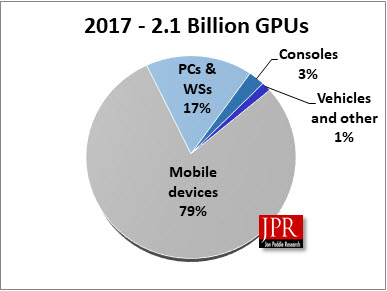Mobiles devices use more GPUs than all other platforms combined.
Jon Peddie Research (JPR), the industry’s research and consulting firm for graphics and multimedia, has released its annual review of GPU developments for 2017.
In spite of the overall slow decline of the PC market, PC-based GPUs sales, which include workstations, have been increasing. In the mobile market, integrated GPUs have risen at the same rate as mobile devices and the SoC in them. The same is true for the console market where integrated graphics are in every console and they too have increased in sales over the year.

We didn’t count the GPUs used in the data center since they don’t drive a display (so the “G” in data-center GPUs is irrelevant). Even if we had included them they would not have made any noticeable amount.
Nearly 28% of the world’s population bought a GPU device in 2017, and that’s in addition to the systems already in use. And yet, probably less than half of them even know the term GPU, what it stands for, or what it does. To them the technology is invisible, and that means it’s working—they don’t have to know about it.
The ubiquity and invisibility of GPUs speaks to their success not just in marketing terms but in terms of real contribution to quality of life, safety, entertainment, and the advancement of science.
The GPU has evolved since its introduction in the late 1990s from a simple programmable geometry processor to an elaborate sea of 32-bit floating point processors running at multiple gigahertz speeds. The software supporting and exploiting the GPU, the programming tools, APIs, drivers, applications, and operating systems have also evolved in function, efficiency, and unavoidably, complexity.
The market for, and use of, GPUs stretches from supercomputers and medical instrumentation to gaming machines, mobile devices, automobiles, and wearables. Just about everyone in the industrialized world has at least a half dozen GPUs, and technophiles can easily count a dozen or more.
The manufacturing of GPUs approaches science fiction with features that will move below 10 nm next year and have a glide-path to 3 nm, and some think even 1 nm—Moore’s law is far from dead, but is getting trickier to tease out of the Genie’s bottle as we drive into subatomic realms that can only be modeled and not seen.
We acquire 90% of the information we digest through our eyes. Naturally, we want and need abundant sources of information-generating devices to supply our unquenchable appetite for yet more information. And the machines we build to service and support us have a similar demand for information, albeit maybe not visible, although in some case such as in robots and autonomous vehicles that’s exactly what they need. The GPU can not only generate pixels, but it can also process photons captured by sensors.
Over the past 12 months, we have seen a few new, and some clever adaptations of GPUs that show the path for future developments, and subsequent applications.
2017 was an amazing year for GPU development driven by games, eSports, AI, crypto currency mining, and simulations. Autonomous vehicles started to become a reality, as did augmented reality. The over hyped consumer-based PC VR market explosion didn’t happen, and had little to no impact on GPU developments or sales. Most of the participants in VR already had a high-end system and the HMD was just another display to them.
Mobile GPUs, exemplified by Qualcomm, ARM, and Imagination Technologies’ customers introduced some amazing devices with long battery life, screens at or approaching 4K, and in 2017 we started talking about and showing HDR.
The calendar is an artificial event marker and the developments in GPUs doesn’t pause for holidays, or annual clock ticks. Many is not all the developments we will see in 2018 were started as early as 2015, and that three- to four-year lead time will continue, if not get longer as we learn how to deal with chips constructed with billions of transistor manufactured at feature sizes smaller than X-rays.
2018 is going to be an even more amazing year, with AI being the leading applications that will permeate every sector of our lives.
About the JPR GPU Developments in 2017 Report
The report is free to all subscribers of JPR. Individual copies of the report can be purchased for $100.
For information about purchasing the “JPR GPU Developments in 2017 Report,” please call 415- 435-9368 or visit Jon Peddie Research at https://www.jonpeddie.com/. Based in Tiburon, California, Jon Peddie Research provides consulting, research, and other specialized services to technology companies, including graphics development, multimedia for professional applications and consumer electronics, high-end computing, and Internet-access product development.





